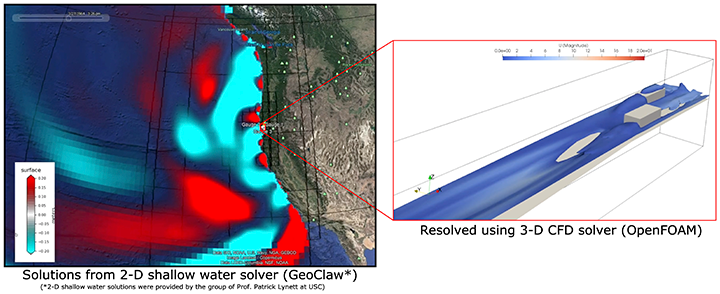The Hydro-UQ Application is open-source software that provides researchers a tool to assess the performance of a building subjected to wave loading due to tsunami and storm surge. The tool facilitates a multiscale coupling by resolving areas of interest by coupling two-dimensional shallow water solver (GeoClaw) with three-dimensional CFD solver (OpenFOAM) through an interchangeable workflow.
The tool facilitates researchers to consider:
In addition, the tool specifically allows for modeling of experiments from wave flumes (for example, the NHERI Experimental Facility at Oregon State University). The outputs of the HydroUQ include probabilistic building responses, velocities and pressure at any point in the fluid domain.
These simulations are computationally demanding and thus, users have the option to perform the computations on the Frontera supercomputer. Frontera is located at the Texas Advanced Computing Center and made available to the user through NSF's NHERI DesignSafe, the cyberinfrastructure provider for NHERI.
Read the
Hydro-UQ Application Summary (V4.0)
To help expand the workflow capabilities with your contributions, contact NHERI-SimCenter@berkeley.edu.

Desktop App
Downloadable app that performs simulations locally or on DesignSafe computing resource
Web Portal
Web portal app that performs simulations on DesignSafe computing resources.
How to cite:
Frank McKenna, Justin Bonus, Ajay B Harish, & Nicolette Lewis. (2024). NHERI-SimCenter/HydroUQ: Version 4.0.0 (v4.0.0). Zenodo. https://doi.org/10.5281/zenodo.13865413
Deierlein, G.G., McKenna, F., et al. (2020). A Cloud-Enabled Application Framework for Simulating Regional-Scale Impacts of Natural Hazards on the Built Environment. Frontiers in Built Environment. 6, 196. doi: 10.3389/fbuil.2020.558706.
Fluid-Structure Interaction
with OpenFOAM and OpenSees
Coupling Regional Tsunami & Storm-Surge Simulation with Local-Scale
Structural Response in Hydro-UQ
Session 1: Introduction to new features and capabilities;Using GeoClaw for shallow-water simulations and coupling with CFD using HydroUQ
Session 2: Using the waveflume digital twin in HydroUQ; Advanced structural modeling and uncertainty quantification
Session 3 & 4: UQ engine Dakota and its interface with Hydro-UQ
Session 5: (LabI):Computing tsunami/storm-surge simulation using GeoClaw, preparing solutions for CFD using HydroUQ+ Running the first CFD solutions with pre-computed GeoClaw solutions
Session 6: Building and using structural models from OpenSees in Hydro-UQ
Session 8: Post-processing with Hydro-UQ